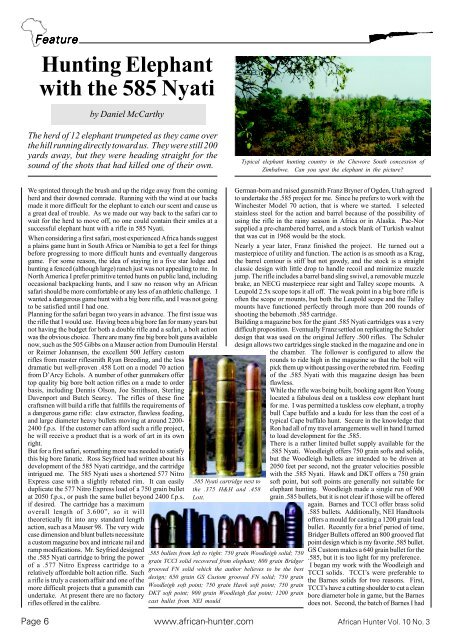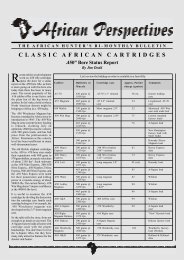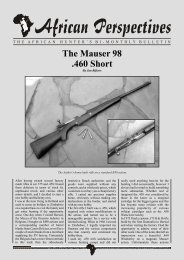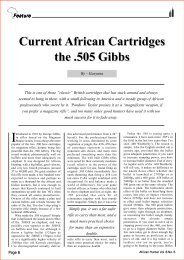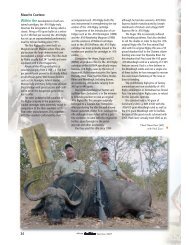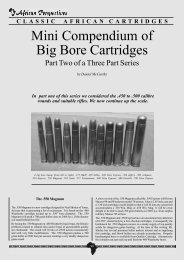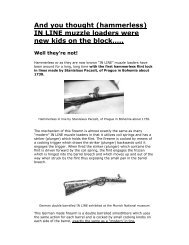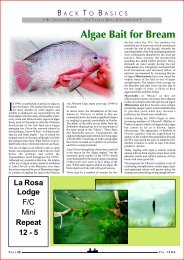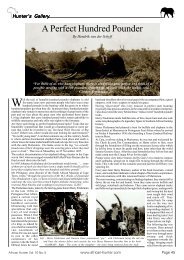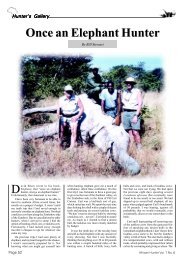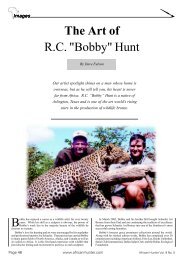Hunting Elephant With The 585 Nyati - HuntNetwork
Hunting Elephant With The 585 Nyati - HuntNetwork
Hunting Elephant With The 585 Nyati - HuntNetwork
You also want an ePaper? Increase the reach of your titles
YUMPU automatically turns print PDFs into web optimized ePapers that Google loves.
Feature<br />
Feature<br />
<strong>Hunting</strong> <strong>Elephant</strong><br />
with the <strong>585</strong> <strong>Nyati</strong><br />
by Daniel McCarthy<br />
<strong>The</strong> herd of 12 elephant trumpeted as they came over<br />
the hill running directly toward us. <strong>The</strong>y were still 200<br />
yards away, but they were heading straight for the<br />
sound of the shots that had killed one of their own.<br />
We sprinted through the brush and up the ridge away from the coming<br />
herd and their downed comrade. Running with the wind at our backs<br />
made it more difficult for the elephant to catch our scent and cause us<br />
a great deal of trouble. As we made our way back to the safari car to<br />
wait for the herd to move off, no one could contain their smiles at a<br />
successful elephant hunt with a rifle in <strong>585</strong> <strong>Nyati</strong>.<br />
When considering a first safari, most experienced Africa hands suggest<br />
a plains game hunt in South Africa or Namibia to get a feel for things<br />
before progressing to more difficult hunts and eventually dangerous<br />
game. For some reason, the idea of staying in a five star lodge and<br />
hunting a fenced (although large) ranch just was not appealing to me. In<br />
North America I prefer primitive tented hunts on public land, including<br />
occasional backpacking hunts, and I saw no reason why an African<br />
safari should be more comfortable or any less of an athletic challenge. I<br />
wanted a dangerous game hunt with a big bore rifle, and I was not going<br />
to be satisfied until I had one.<br />
Planning for the safari began two years in advance. <strong>The</strong> first issue was<br />
the rifle that I would use. Having been a big bore fan for many years but<br />
not having the budget for both a double rifle and a safari, a bolt action<br />
was the obvious choice. <strong>The</strong>re are many fine big bore bolt guns available<br />
now, such as the 505 Gibbs on a Mauser action from Dumoulin Herstal<br />
or Reimer Johannsen, the excellent 500 Jeffery custom<br />
rifles from master riflesmith Ryan Breeding, and the less<br />
dramatic but well-proven .458 Lott on a model 70 action<br />
from D’Arcy Echols. A number of other gunmakers offer<br />
top quality big bore bolt action rifles on a made to order<br />
basis, including Dennis Olson, Joe Smithson, Sterling<br />
Davenport and Butch Searcy. <strong>The</strong> rifles of these fine<br />
craftsmen will build a rifle that fulfills the requirements of<br />
a dangerous game rifle: claw extractor, flawless feeding,<br />
and large diameter heavy bullets moving at around 2200-<br />
2400 f.p.s. If the customer can afford such a rifle project,<br />
he will receive a product that is a work of art in its own<br />
right.<br />
But for a first safari, something more was needed to satisfy<br />
this big bore fanatic. Ross Seyfried had written about his<br />
development of the <strong>585</strong> <strong>Nyati</strong> cartridge, and the cartridge<br />
intrigued me. <strong>The</strong> <strong>585</strong> <strong>Nyati</strong> uses a shortened 577 Nitro<br />
Express case with a slightly rebated rim. It can easily<br />
duplicate the 577 Nitro Express load of a 750 grain bullet<br />
at 2050 f.p.s., or push the same bullet beyond 2400 f.p.s.<br />
if desired. <strong>The</strong> cartridge has a maximum<br />
overall length of 3.600”, so it will<br />
theoretically fit into any standard length<br />
action, such as a Mauser 98. <strong>The</strong> very wide<br />
case dimension and blunt bullets necessitate<br />
a custom magazine box and intricate rail and<br />
ramp modifications. Mr. Seyfried designed<br />
the .<strong>585</strong> <strong>Nyati</strong> cartridge to bring the power<br />
of a .577 Nitro Express cartridge to a<br />
relatively affordable bolt action rifle. Such<br />
a rifle is truly a custom affair and one of the<br />
more difficult projects that a gunsmith can<br />
undertake. At present there are no factory<br />
rifles offered in the calibre.<br />
.<strong>585</strong> <strong>Nyati</strong> cartridge next to<br />
the .375 H&H and .458<br />
Lott.<br />
.<strong>585</strong> bullets from left to right: 750 grain Woodleigh solid; 750<br />
grain TCCI solid recovered from elephant; 800 grain Bridger<br />
grooved FN solid which the author believes to be the best<br />
design; 650 grain GS Custom grooved FN solid; 750 grain<br />
Woodleigh soft point; 750 grain Hawk soft point; 750 grain<br />
DKT soft point; 900 grain Woodleigh flat point; 1200 grain<br />
cast bullet from NEI mould<br />
Typical elephant hunting country in the Chewore South concession of<br />
Zimbabwe. Can you spot the elephant in the picture?<br />
German-born and raised gunsmith Franz Bryner of Ogden, Utah agreed<br />
to undertake the .<strong>585</strong> project for me. Since he prefers to work with the<br />
Winchester Model 70 action, that is where we started. I selected<br />
stainless steel for the action and barrel because of the possibility of<br />
using the rifle in the rainy season in Africa or in Alaska. Pac-Nor<br />
supplied a pre-chambered barrel, and a stock blank of Turkish walnut<br />
that was cut in 1968 would be the stock.<br />
Nearly a year later, Franz finished the project. He turned out a<br />
masterpiece of utility and function. <strong>The</strong> action is as smooth as a Krag,<br />
the barrel contour is stiff but not gawdy, and the stock is a straight<br />
classic design with little drop to handle recoil and minimize muzzle<br />
jump. <strong>The</strong> rifle includes a barrel band sling swivel, a removable muzzle<br />
brake, an NECG masterpiece rear sight and Talley scope mounts. A<br />
Leupold 2.5x scope tops it all off. <strong>The</strong> weak point in a big bore rifle is<br />
often the scope or mounts, but both the Leupold scope and the Talley<br />
mounts have functioned perfectly through more than 200 rounds of<br />
shooting the behemoth .<strong>585</strong> cartridge.<br />
Building a magazine box for the giant .<strong>585</strong> <strong>Nyati</strong> cartridges was a very<br />
difficult proposition. Eventually Franz settled on replicating the Schuler<br />
design that was used on the original Jeffery .500 rifles. <strong>The</strong> Schuler<br />
design allows two cartridges single stacked in the magazine and one in<br />
the chamber. <strong>The</strong> follower is configured to allow the<br />
rounds to ride high in the magazine so that the bolt will<br />
pick them up without passing over the rebated rim. Feeding<br />
of the .<strong>585</strong> <strong>Nyati</strong> with this magazine design has been<br />
flawless.<br />
While the rifle was being built, booking agent Ron Young<br />
located a fabulous deal on a tuskless cow elephant hunt<br />
for me. I was permitted a tuskless cow elephant, a trophy<br />
bull Cape buffalo and a kudu for less than the cost of a<br />
typical Cape buffalo hunt. Secure in the knowledge that<br />
Ron had all of my travel arrangements well in hand I turned<br />
to load development for the .<strong>585</strong>.<br />
<strong>The</strong>re is a rather limited bullet supply available for the<br />
.<strong>585</strong> <strong>Nyati</strong>. Woodleigh offers 750 grain softs and solids,<br />
but the Woodleigh bullets are intended to be driven at<br />
2050 feet per second, not the greater velocities possible<br />
with the .<strong>585</strong> <strong>Nyati</strong>. Hawk and DKT offers a 750 grain<br />
soft point, but soft points are generally not suitable for<br />
elephant hunting. Woodleigh made a single run of 900<br />
grain .<strong>585</strong> bullets, but it is not clear if those will be offered<br />
again. Barnes and TCCI offer brass solid<br />
.<strong>585</strong> bullets. Additionally, NEI Handtools<br />
offers a mould for casting a 1200 grain lead<br />
bullet. Recently for a brief period of time,<br />
Bridger Bullets offered an 800 grooved flat<br />
point design which is my favorite .<strong>585</strong> bullet.<br />
GS Custom makes a 640 grain bullet for the<br />
.<strong>585</strong>, but it is too light for my preference.<br />
I began my work with the Woodleigh and<br />
TCCI solids. TCCI’s were preferable to<br />
the Barnes solids for two reasons. First,<br />
TCCI’s have a cutting shoulder to cut a clean<br />
bore diameter hole in game, but the Barnes<br />
does not. Second, the batch of Barnes I had<br />
Page 6 www.african-hunter.com African Hunter Vol. 10 No. 3
suffered from significant<br />
variances in location of the<br />
cannelure, giving each bullet<br />
its own individualized<br />
personality. <strong>The</strong><br />
consistency of the TCCI’s<br />
and Woodleighs was<br />
excellent, however.<br />
After using several powders,<br />
I finally settled on 130 grains<br />
of Reloader 15 and Federal’s<br />
215 primer with both the<br />
Woodleigh and TCCI solids.<br />
That load chronographs an<br />
average of 2267 f.p.s. from<br />
the Model 70 with the TCCI<br />
bullet. Recoil is startling but<br />
manageable. From the bench<br />
at 100 yards I could shoot 1<br />
¼ to 1 ¾ inch groups, and<br />
offhand the rifle could be<br />
controlled without undue<br />
difficulty. Recoil would<br />
generally move my shoulder back about a foot, but it was more of a big<br />
shove than a sharp jab. <strong>The</strong> recoil of this round is not painful, but the<br />
shooter must hold the rifle tightly and be psychologically prepared for<br />
his shot. <strong>The</strong> additional 200 f.p.s. that my load achieves beyond the<br />
original 577 Nitro Express load was intended to provide increased<br />
penetration on the largest game animal.<br />
<strong>With</strong> the rifle and load ready to go and all particulars of the hunt<br />
arranged, I boarded a South African Airways 747 in Atlanta and headed<br />
for Zimbabwe via Johannesburg. <strong>With</strong> the help of a sleeping pill, I<br />
temporarily conquered my excitement and slept nearly the entire way,<br />
arriving in Harare, Zimbabwe with little jet lag. In Harare I noted that<br />
several airport employees “assisted” me in locating my firearms, clearing<br />
them through customs and proceeding to the safari car (a red Toyota<br />
Land Cruiser diesel). In exchange for that assistance, I tipped the locals<br />
in the hope that they would find assisting hunters more profitable than<br />
pilfering items from luggage as is so common in many third world<br />
countries. Later I learned that the professional hunter had also tipped<br />
them, and I wonder if airport employees face any ethical constraint<br />
against double dipping.<br />
<strong>The</strong> professional hunter for this trip was Peter Wood of Roger Whittall<br />
Safaris. Peter is a very experienced and enthusiastic elephant hunter<br />
and was eager to get on the road to the Chewore South game concession.<br />
In Zimbabwe, a game concession is government-owned land on which<br />
no people are permitted to live. <strong>The</strong> land is completely reserved for<br />
game and hunting. A safari company leases the concession and only<br />
allows its staff and clients to enter the land. <strong>The</strong>re is a great advantage<br />
in this arrangement since the presence of other humans would tend to<br />
interfere with any hunt.<br />
We arrived at the camp just after dark and relaxed for the evening. <strong>The</strong><br />
next morning we checked the zero on my rifle (it had not moved) and<br />
went hunting. We tracked and saw elephant every day, and on day<br />
three a professional hunter trainee in our camp saw a tuskless cow<br />
walking along a river bottom. First thing the next morning we were on<br />
her tracks and moved hard and fast from first light until 11 a.m. when<br />
she moved across a river and out of the concession. Tired and<br />
disappointed, we returned to the Toyota. Our luck soon turned, as one<br />
of the trackers spotted another group<br />
of elephant from the back of the<br />
vehicle. Use of the binoculars revealed<br />
three tuskless cows in the group and<br />
we began our stalk. Sometimes luck is<br />
better than hard work.<br />
We set off after the elephant and first<br />
moved several hundred yards uphill to<br />
gain a wind advantage and then moved<br />
to within 25 yards of our target. During<br />
previous discussions with Peter, I had<br />
decided to use a heart-lung shot on my<br />
elephant rather than a brain shot. <strong>The</strong><br />
brush was thick and Peter called out<br />
when to shoot as one of the tuskless<br />
cows moved into a relative clearing. At<br />
the shot the elephant turned 90 degrees<br />
away from me and began to run. I put<br />
Above - Tuskless cow elephant downed with two shots from the<br />
.<strong>585</strong> <strong>Nyati</strong>. <strong>The</strong> first shot was a 750 grain Woodleigh solid,<br />
followed by a 750 grain TCCI solid.<br />
Right - <strong>Elephant</strong> heart showing bullet damage from a .<strong>585</strong>”<br />
diameter 750 grain Woodleigh solid.<br />
Cape buffalo downed with one shot from the .<strong>585</strong> <strong>Nyati</strong>.<br />
the next shot at the base of<br />
her tail, just off the spine,<br />
and she went down.<br />
Another elephant in the<br />
herd began pushing the<br />
fallen cow to urge her to get<br />
up. When several attempts<br />
were not successful, the<br />
remainder of the elephant<br />
in the herd moved off.<br />
Elated, we all walked to the<br />
downed elephant. Peter<br />
had me fire another shot<br />
into the elephant’s lungs<br />
through the top of her back,<br />
and a final shot into her<br />
lungs through the bottom of<br />
her chest. It seems that<br />
downed elephant are<br />
famous for getting up and<br />
running away and Peter did<br />
not want any such<br />
surprises.<br />
Those additional two shots caused a commotion, however. We heard<br />
elephant trumpeting and saw the herd that we had just scared off<br />
running our way. <strong>The</strong>y were about 200 yards out but were headed for<br />
the sound of the rifle shots. In the 110 degree heat and strong sun, we<br />
sprinted to safety. I am sure that is not as terrifying as a close range<br />
charge, but it was plenty of excitement so we moved out of the area to<br />
let things settle down.<br />
<strong>The</strong> .<strong>585</strong> <strong>Nyati</strong> proved itself a capable elephant round, although there<br />
was never any real doubt. <strong>The</strong> first shot was with a Woodleigh solid<br />
and passed through the top of the heart and bottom of the lungs. <strong>The</strong><br />
skinners did not recover the bullet and it may have exited. <strong>The</strong> second<br />
shot did not break the spine but hit so close to it that the shock knocked<br />
the elephant down. I recovered one of the TCCI solids undamaged and<br />
as new except for the rifling marks on it. <strong>The</strong> load I had selected<br />
generates mild pressure so extraction was not a problem even in the<br />
heat of the Zimbabwe summer. <strong>The</strong> .<strong>585</strong> <strong>Nyati</strong> had done its job and<br />
served the function for which Ross Seyfried designed it. <strong>The</strong> elephant<br />
visibly reacted to both shots, and was on the ground within several<br />
strides of where she was standing at the first shot. <strong>The</strong> professional<br />
hunter did not need to fire his rifle, although it was comforting to have<br />
him there. I was very pleased that the .<strong>585</strong> <strong>Nyati</strong> hunting experiment<br />
seemed to be a success. But just to be sure, I decided to test it further.<br />
We had been glassing Cape buffalo each day, but after taking the elephant,<br />
we went after Cape buffalo in earnest. Following the tracks of dagga<br />
boys (a pair of older bachelor bulls) for more than six miles, I had a<br />
chance for a broadside shot at one of the bulls from 25 yards. <strong>The</strong><br />
TCCI solid from the <strong>585</strong> <strong>Nyati</strong> passed through both lungs and broke<br />
the offside shoulder. <strong>The</strong> buffalo ran 20 yards or so where he piled up.<br />
His partner gave us a bluff charge at more of a trot than a run, but<br />
changed his mind on hearing a warning shot from the <strong>585</strong> <strong>Nyati</strong>.<br />
Through the hard work and planning of many people, my new rifle and<br />
my hunt were a great success. I suppose that neither elephant hunting<br />
nor the <strong>585</strong> <strong>Nyati</strong> are for everyone. <strong>Elephant</strong> hunting generally requires<br />
walking great distances at a rapid pace in the hot sun. Even rigorous elk<br />
and deer hunting in the steep Rocky Mountains and long backpacking<br />
trips did not prepare me for the pace that the trackers set. <strong>The</strong> <strong>585</strong><br />
<strong>Nyati</strong> is an impressive although<br />
daunting package. Personally, I can<br />
only tolerate 10-15 rounds of full<br />
power loads before a headache sets<br />
in. Rifles for this calibre are difficult<br />
to build and few gunsmiths will or<br />
should undertake the challenge. Dies,<br />
brass and bullets are expensive and<br />
substantial skill as a handloader is<br />
needed to produce cartridges that a<br />
person’s life can depend on. <strong>The</strong><br />
typical hunter will be much better<br />
served with a .458 Lott, a .416 Rigby,<br />
or even a .375 H&H for many<br />
practical reasons. But the success of<br />
my .<strong>585</strong> <strong>Nyati</strong> on elephant and Cape<br />
buffalo makes this hunt one of my<br />
fondest memories.<br />
Page 8 www.african-hunter.com African Hunter Vol. 10 No. 3


